Synthesis, Crystal Structure and Electrical Properties of the Molybdenum Oxide Na1.92Mg2.04Mo3O12
Abstract
New molybdenum oxide Na1.92Mg2.04Mo3O12 has been synthesized by the solid state method. The title compound crystallizes in the triclinic system (space group P-1). The unit cell parameters are a = 6.9660(7) Å, b = 8.6352(8) Å, c = 10.2501(8) Å, α = 106.938(1)°, β = 104.825(1)°, γ = 103.206(1)°, V = 538.72(9) Å3, and Z = 2. The compound is isotypical to Ag2M2(MoO4)3 (M = Zn, Mg, Co, Mn). The structure can be described as a three-dimensional anionic mixed framework of MoO4 tetrahedra and pairs of Mg2O10 octahedra sharing common edges. The Na+ ions are disordered and located in the voids forming infinite channels running along the direction [100]. The electrical conductivity investigated from 693 K to 793 K by AC impedance spectroscopy is low (3.01 × 10−7 S cm−1 at 683 K).
1. Introduction
The interest in the study of alkali molybdenum oxides is primarily in the unique structural and physical properties of some of these compounds which include high anisotropic transport properties [1, 2] and superconductivity and in their important application in the field of energy and electronics as described in several reviews [3, 4]. Some of complex molybdates crystallize in structure types which show significant ionic conductivity. For example, the structure of the Nasicon type molybdate [5] is of great interest because of high ionic conduction. For this reason the characterization of those oxides seems to be an important task. In our investigation, we synthesize new crystal of molybdenum oxide Na1.92Mg2.04Mo3O12.
In our bibliographical search, we found the study of the phase diagram of the system Na2MoO4-MgMoO4 [6]; the system contains a single intermediate compound Na2Mg5(MoO4)6 [7]. The structural study reveals that the compound is isotypical to Na2Mg5(MoO4)6 [7], Ag2M2(MoO4)3 (M = Co, Mn, Mg, Zn) [8–10], and Na0.5Zn2.75(MoO4)3 [11].
(The cif file corresponding to the studied structure has been deposited in the database of Karlsruhe Number CSD. 426651 (http://www.fiz-karlsruhe.de/icsd.html)).
2. Experimental Details
2.1. Synthesis
The compound is synthesized by the solid state method. A stoichiometric mixture of NaCO3 (Fluka, 71350), (NH4)2Mo4O13 (Fluka, 69858), and Mg(NO3)2·6H2O (Fluka, 63079), placed in a porcelain crucible, is slowly annealed in air at 350°C for 12 hours, in order to eliminate volatile products. The resulting mixtures were heated at 540°C for 7 days in air. Then, they were slowly cooled at 5°C/day to 490°C and finally, they were cooled at 50°C/day to room temperature. Single colorless crystals of double molybdates were grown by spontaneous crystallizations from stoichiometric melts. The compound is isotypical to Na2Mg5(MoO4)6 [4] and Ag2M2(MoO4)3(M = Co, Mn, Mg, Zn) [7–9] and contains mixed frameworks of MoO4 tetrahedra and pairs of MgO6 octahedra sharing common edges.
2.2. X-Ray Data Collection
Data collection was performed with a CAD-4 Enraf-Nonius X-ray diffractometer [12] at 298 K with graphite monochromator using MoKα wavelength. An empirical psi-scan [13] absorption correction was applied. The structure was solved and refined by full-matrix least squares based on F2 using SHELXS-97 and SHELXL-97 [14, 15], respectively. In the closest solution proposed by the program, only some molybdenum atoms and magnesium atoms were located. Using SHELXL-97 program, refinements followed by Fourier differences were necessary to find the positions of the other atoms remaining in the lattice yielding a good R factor of 2.18% for all reflections and allowing the revolution of the positions of 12 peaks of oxygen atoms on the difference Fourier map. The structure graphics were drawn with diamond 2.1 supplied by Crystal Impact [16]. Crystal data and structure refinements details are summarized in Table 1. The atomic coordinates and isotropic thermal factors are presented in Table 2. Table 3 contains the main interatomic distances in the coordination polyhedra of the studied structure.
| Empirical formula | Na1.92Mg2.04Mo3O12 |
| Formula weight (g/mol) | 573.55 |
| Crystal system, space group | Triclinic, P-1 |
| a (Å) | 6.9660(7) |
| b (Å) | 8.6352(8) |
| c (Å) | 10.2501(8) |
| α (°) | 106.938(1) |
| β (°) | 104.825(1) |
| γ (°) | 103.206(1) |
| V (Å3) | 538.72(9) |
| Z | 2 |
| μ (mm−1) | 3.69 |
| Dx (g·cm−3) | 3.536 |
| F(000) | 535 |
| Crystal size (mm) | 0.28 × 0.18 × 0.14 |
| Crystal habit | Colourless prism |
| Tmin/Tmax | 0.4244/0.6258 |
| Measured reflections | 3666 |
| Independent reflections | 2338 |
| Observed refl. with I > 2σ(I) | 2211 |
| Rint | 0.021 |
| Data/restraints/parameters | 2338/1/184 |
| R[F2 > 2σ(F2)] | 0.022 |
| wR(F2) | 0.058 |
| GooF = S | 1.16 |
| Δρmax/Δρmin (e·Å−3) | 0.78/−0.84 |
| Atom | x | y | z | Uiso | Occ. (<1) |
|---|---|---|---|---|---|
| Mo1 | 0.1142(4) | 0.0912(4) | 0.3329(3) | 0.0104(7) | |
| Mo2 | 0.7850(4) | 0.3354(4) | 0.7400(3) | 0.0105(7) | |
| Mo3 | 0.5948(8) | 0.2594(4) | 0.1303(4) | 0.0133(5) | |
| Mg1 | 0.0424(2) | 0.2000(8) | 0.0174(8) | 0.0107(3) | |
| Mg2 | 0.6224(2) | 0.0434(8) | 0.3953(7) | 0.0120(3) | |
| Na1 | 0.7123(3) | 0.7072(2) | 0.1966(2) | 0.0219(6) | 0.917(9) |
| Mg11 | 0.7123(3) | 0.7072(2) | 0.1966(2) | 0.0219(6) | 0.042(8) |
| Na2 | 0.4759(9) | 0.5336(9) | 0.5487(8) | 0.0900(3) | 0.50 |
| Na3 | 0.0340(2) | 0.507(2) | 0.5199(9) | 0.0290(2) | 0.50 |
| O1 | 0.7258(7) | 0.4739(5) | 0.2418(5) | 0.0544(9) | |
| O2 | 0.3473(5) | 0.2349(4) | 0.0075(3) | 0.0198(6) | |
| O3 | 0.1729(6) | 0.3074(4) | 0.4221(4) | 0.0283(7) | |
| O4 | 0.7536(5) | 0.1913(4) | 0.0362(3) | 0.0221(7) | |
| O5 | 0.0790(4) | 0.0561(3) | 0.1472(3) | 0.0124(5) | |
| O6 | 0.7797(5) | 0.2956(4) | 0.5600(3) | 0.0177(6) | |
| O7 | 0.8334(5) | 0.5524(4) | 0.8268(3) | 0.0229(7) | |
| O8 | 0.5351(5) | 0.2240(4) | 0.7349(3) | 0.0184(6) | |
| O9 | 0.9802(4) | 0.2684(4) | 0.8377(3) | 0.0178(6) | |
| O10 | 0.5657(6) | 0.1487(6) | 0.2471(4) | 0.0363(9) | |
| O11 | 0.3273(4) | 0.0301(4) | 0.4206(3) | 0.0132(5) | |
| O12 | 0.8781(5) | 0.9886(4) | 0.3507(3) | 0.0184(6) |
| Bond distances (Å) | |
|---|---|
| Mo1–O3 | 1.718(3) |
| Mo1–O12i | 1.762(3) |
| Mo1–O5 | 1.780(3) |
| Mo1–O11 | 1.800(3) |
| Mo2–O7 | 1.732(3) |
| Mo2–O6 | 1.765(3) |
| Mo2–O8 | 1.766(3) |
| Mo2–O9 | 1.785(3) |
| Mo3–O4 | 1.736(3) |
| Mo3–O1 | 1.740(4) |
| Mo3–O10 | 1.758(3) |
| Mo3–O2 | 1.780(3) |
| Mg1–O4vii | 2.056(3) |
| Mg1–O9viii | 2.067(3) |
| Mg1–O5 | 2.076(3) |
| Mg1–O7ii | 2.080(3) |
| Mg1–O2 | 2.109(3) |
| Mg1–O5iii | 2.167(3) |
| Mg2–O10 | 1.989(4) |
| Mg2–O12ix | 2.070(3) |
| Mg2–O11 | 2.119(3) |
| Mg2–O11iv | 2.132(3) |
| Mg2–O6 | 2.148(3) |
| Mg2–O8iv | 2.149(3) |
| Na1–O8ii | 2.158(3) |
| Na1–O1 | 2.211(6) |
| Na1–O9v | 2.232(3) |
| Na1–O2vi | 2.250(3) |
| Na1–O12 | 2.298(4) |
| Na2–O3 | 2.279(8) |
| Na2–O3ii | 2.411(9) |
| Na2–O6ii | 2.780(3) |
| Na2–O1ii | 2.859(9) |
| Na3–O3 | 2.272(18) |
| Na3–O6ii | 2.371(19) |
| Na3–O3x | 2.437(17) |
| Na3–O6vii | 2.440(19) |
| Na3–O1ii | 2.518(11) |
| Na3–O1vii | 2.989(10) |
- Symmetry codes: ix − 1, y − 1, z; ii−x + 1, −y + 1, −z + 1; iii−x, −y, −z; iv−x + 1, −y, −z + 1; v−x + 1, −y + 1, −z + 1; vi−x + 1, −y + 1, −z; viix − 1, y, z; viiix − 1, y, z − 1; ixx, y − 1, z; x−x, −y + 1, −z + 1.
3. Results and Discussion
3.1. Structure Description
The title compound is a new member of isostructural phases family including Na2Mg5(MoO4)6 [7], Ag2 M2(MoO4)3 (M = Co, Mn, Mg, Zn) [8–10], and to Na0.5Zn2.75(MoO4)3 [11]. The cell parameters of those compounds are given in Table 4.
| Compound | Space group | Cell parameters (Å, °) |
|---|---|---|
| Na2Mg5(MoO4)6 | Triclinic P-1 |
|
| Ag2Mg2(MoO4) | Triclinic P-1 |
|
| Ag2Co2(MoO4) | Triclinic P-1 |
|
| Ag2Zn2(MoO4) | Triclinic P-1 |
|
| Na0.5Zn2.75(MoO4)3 | Triclinic P-1 |
|
The asymmetric unit in Na1.92Mg2.04Mo3O12 compound is shown in Figure 1. The structure is composed of two octahedra Mg2O10 and three tetrahedra MoO4 sharing corners and forming a cyclic group Mg2Mo3O19. The charge compensation in the asymmetric unit is ensured by Na+ cations.
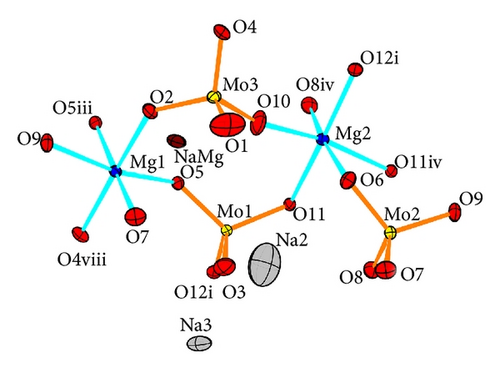
The structure may be represented as a three-dimensional mixed framework of pairs of MgO6 octahedra sharing common edges forming Mg2O10 group, linked to MoO4 tetrahedra by corners. Each two Mg2O10 octahedra sharing edges are surrounded either by ten tetrahedra forming Mg(1)2Mo10O40 group (Figure 2(a)) or by eight tetrahedra forming Mg(2)2Mo8O32 group (Figure 2(b)).
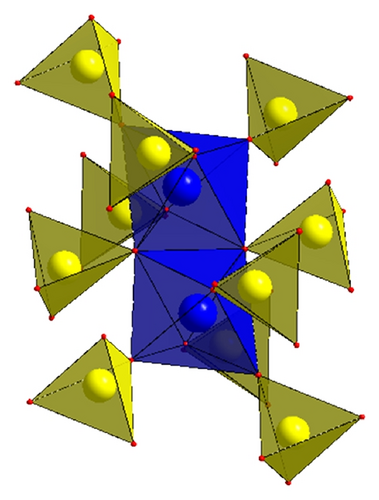
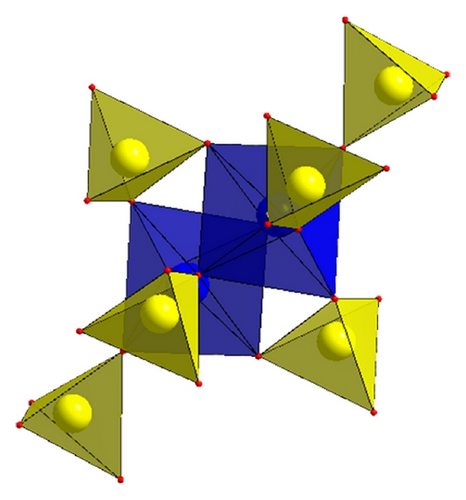
The projection of the structure along [100] and [001] directions shows the presence of layers in the ac plane which are connected by Mo(2)O4 polyhedra forming two types of tunnels hexagonal along [100] direction (Figure 3) and squared along [001] direction (Figure 4). The monovalent cations are located in tunnels forming infinite channels.
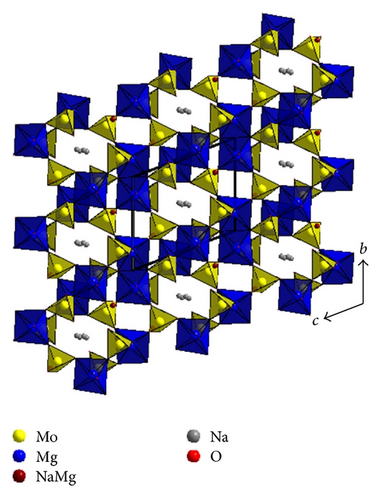
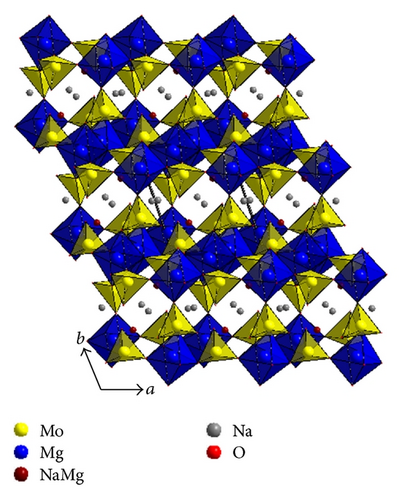
The projection of a layer along the direction [010] shows the presence of two types of Mg(1)2Mo10O40 and Mg(2)2Mo8O32 chains connected by MoO4 tetrahedra (Figure 5).
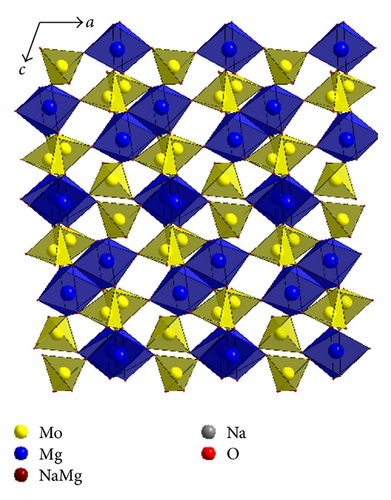
In the crystal structure of Na1.92Mg2.04Mo3O12, the Mo atom has a tetrahedral oxygen coordination, with Mo–O distances varying within 1.718(3)–1.800(4) Å with the average of 1.760 Å close to the common values [14]. Magnesium cations occupy two crystallographically independent sites Mg1 and Mg2, which are located in an octahedral environment with (d (Mg1–O) = 2.056(3)–2.167(3) Å) and (d (Mg2–O = 1.989(4)–2.158(3) Å) with the average of 2.100 Å.
Sodium atoms occupy three different positions Na(1), Na(2), and the third site which is occupied by (Na+, Mg2+). The (Na1/Mg11)–O bond lengths vary from 2.15 to 2.29 Å (Table 3). In fact, we remark that the short distance Na–O is shorter than normal which indicates that the occupation is partial with the M2+ atom.
The (Na1/Mg11)O5 is surrounded by five oxygen atoms (CN = 5). The voids between layers are occupied by sodium atoms: Na2 and Na3 are in the middle of concavities; (Na1/Mg11) lie on the extremity of the concavity attracted to polyhedra of two adjacent layers (Figure 4).
3.2. Electrical Measurements
The electrical properties of Na1.92Mg2.04Mo3O12 ceramic have been investigated using complex impedance spectroscopy. Impedance spectroscopy measurements were carried out in a Hewlett-Packard 4192-A automatic bridge monitored by an HP microcomputer. The electrical measurements are realized in the thermal range 693–743 K and frequency range of 5 Hz–13 MHz. Pellet was prepared by isostatic pressing at 4 kbar and sintering at 480°C for 2 h in air with 5 K·min−1 heating and cooling rates. The thickness and surface of pellet were about 0.159 cm and 0.807 cm2 having a geometric factor of e/S = 0.197 cm−1. Platinum electrodes were painted in the two faces of the pellet with a platinum paste to ensure good electric contacts. The Nyquist plots at different temperatures are shown in Figure 6. When temperature increases, the radius of semicircles decreases, which indicates an activated conduction mechanism. The intercepts of the semicircular arcs with the real axis give an estimation of the resistance of material. We have used the Zview software [17] to fit these curves. The measured impedance can be modeled as an equivalent electrical circuit composed of a resistor, R, connected in parallel with a constant phase element, CPE [18]. By knowing the value of resistance and the dimensions of the sample, the conductivity has been calculated at each temperature.
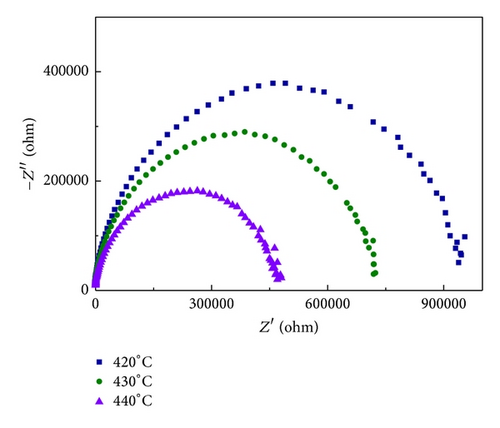
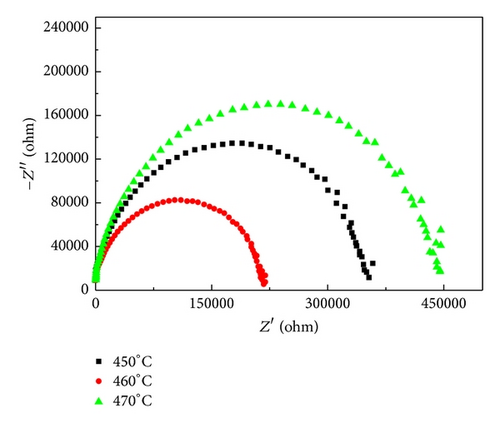
The variation of log (σT(S·K·cm−1)) versus 1000/T (K−1) is represented in Figure 7. The conductivity value at 683 K is 3.01 × 10−7 S cm−1 and the activation energy for Na+ ions migration deduced from the slope is Ea = 1.37 eV; Na1.92Mg2.04Mo3O12 shows a low electric conductivity, when compared to those found for other molybdenum oxide compounds (Table 5) [19, 20].
| Compound | Temperature range (°C) | Ea (eV) | σ (S·cm−1) |
|---|---|---|---|
| Li3Cr(MoO4)3 | 200–400 | 1.06 | 2.6 × 10−6 (300°C) |
| Na5Sc(MoO4)3 | — | 0.72 | 6 × 10−6 (300°C) |
| Li2Mg2(MoO4)3 | 200–400 | 0.71 | 1.1 × 10−7 (300°C) |
| Na2In2Mo5O16 | — | 0.79 | 2 × 10−7 (275°C) |
| Li1.8Mg2.1(MoO4)3 | 200–400 | 0.63 | 6.1 × 10−8 (300°C) |
| Li1.6Mg2.2(MoO4)3 | 200–400 | 0.76 | 1.4 × 10−8 (300°C) |
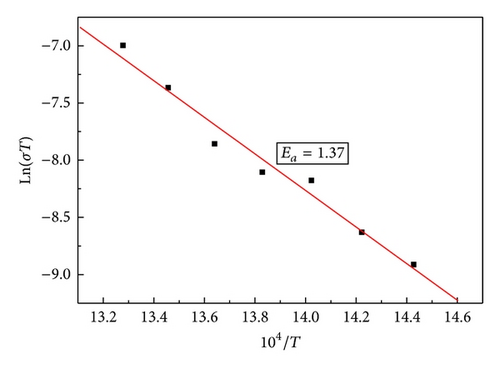
4. Conclusion
New molybdate Na1.92Mg2.04Mo3O12 is synthesized by a solid state method. The structure of our compound has been solved by using X-ray diffraction. The compound is formed by bioctahedra M2O10 and MoO4 tetrahedra connected via common vertices. The structure of this material has an open framework having different interconnecting tunnels running along [100] and [001] where the Na+ ions are located. The electrical properties of the title compound are investigated using complex impedance spectroscopy. The conductivity value at 683 K is 3.01 × 10−7 S cm−1 and the activation energy for Na+ ions migration is Ea = 1.37 eV. Na1.92Mg2.04Mo3O12 presents a low electric conductivity.




